As you step into your backyard, you're met with a blank slate, begging for transformation. You envision a serene oasis, where you can unwind and entertain with ease. But where do you start? By incorporating a mix of textures, colors, and shapes, you can create an inviting atmosphere that's uniquely yours. From patio furniture to native plants, every element plays a pivotal role in bringing your outdoor space to life. Now, it's time to explore the possibilities – and we're about to uncover the secrets to turning your backyard into a stunning retreat.
Inviting Patio Design Ideas

When designing your patio, incorporating a mix of textures, colors, and shapes can create an inviting atmosphere that beckons you to linger outdoors.
To achieve this, consider selecting patio furniture that not only provides comfort but also adds visual appeal. Opt for seating options that combine different materials, such as wooden frames with cushions, or metal legs with wicker seats. This contrast of textures will add depth and interest to your patio.
In terms of colors, choose a palette that complements your home's exterior and surrounding landscape. You can also incorporate pops of color through throw pillows, rugs, or planters to create a cohesive look.
Don't forget to balance large pieces of furniture with smaller decorative elements, like side tables or plant stands, to maintain a sense of harmony. By thoughtfully selecting patio furniture and seating options, you'll create a patio that's both functional and aesthetically pleasing, making it the perfect spot to relax and entertain.
Lush Lawn Care Essentials
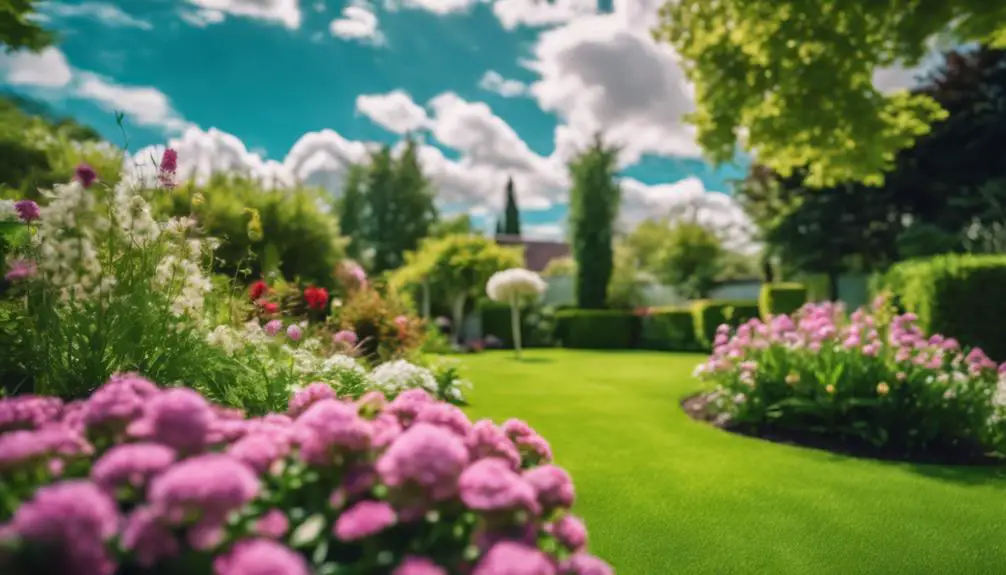
As you aim for a lush, vibrant lawn, you'll want to focus on three key elements: the quality of your soil, a well-planned watering schedule, and mowing at the right height.
By getting these fundamentals right, you'll be well on your way to a healthy, thriving lawn that's the envy of the neighborhood.
Soil Quality Matters
By digging into the composition of your soil, you'll uncover the underlying factors that can make or break your lush lawn dreams, from nutrient deficiencies to poor drainage.
Soil testing is a vital step in understanding your soil's unique needs. A soil test will reveal the pH level, nutrient content, and contaminants present in your soil.
This information will help you identify areas for improvement and create a tailored plan to optimize your soil's composition.
When examining your soil composition, consider the ratio of sand, silt, and clay. A balanced mix of these elements will guarantee proper water infiltration, aeration, and nutrient uptake.
If your soil is heavy on clay, it may be prone to waterlogging, while sandy soils may struggle with water retention.
By understanding these intricacies, you can amend your soil with organic matter, fertilizers, or other additives to create an ideal environment for your lawn to thrive.
Watering Schedule Tips
You'll need to strike a delicate balance between hydration and drainage by establishing a thoughtful watering schedule, one that caters to your lawn's specific needs and adapts to seasonal fluctuations.
A well-planned schedule will prevent overwatering, which can lead to shallow root growth and increased susceptibility to disease. Invest in smart irrigation systems that utilize weather data and soil moisture levels to optimize water distribution.
On rainy days, adjust your schedule to avoid excess water and prevent waterlogged soil.
Visualize your lawn as a sponge, absorbing and releasing water as needed.
In the spring, when the lawn is actively growing, increase watering frequency to promote healthy development.
During the hot summer months, reduce watering to prevent evaporation and encourage deep root growth.
As the weather cools in the fall, gradually decrease watering to prepare your lawn for dormancy.
Mowing Height Guide
Set your mower to the ideal height for your lawn type, as this will determine the health and appearance of your grass, with heights ranging from 2.5 inches for cool-season grasses to 3 inches for warm-season varieties.
You'll want to maintain a consistent mowing height to promote healthy growth and prevent weed growth. For most lawns, a height of 2.5 to 3 inches is ideal, as it allows the grass to grow deep roots and shade out weeds.
When mowing, leave the grass clippings on the lawn to act as a natural fertilizer, reducing the need for synthetic fertilizers.
This will also help to retain moisture and reduce evaporation. Additionally, consider incorporating lawn aeration into your maintenance routine to improve airflow and reduce soil compaction.
This will help your lawn breathe and absorb nutrients more efficiently.
Flower Bed Arrangement Tips

The secret to creating a visually stunning flower bed arrangement that draws the eye and invites exploration starts with choosing a clear flower bed theme that ties together the entire design.
Consider a monochromatic scheme, a riot of colorful blooms, or a serene oasis-inspired arrangement.
Next, think about the blooming patterns of your chosen flowers. Will they burst forth in a riot of color in the spring, or provide a steady stream of blooms throughout the growing season?
To create visual interest, vary the heights and textures of your plants.
Place taller flowers or shrubs towards the back of the bed, with shorter, more delicate blooms towards the front.
Consider adding ornamental grasses or shrubs to provide structure and depth.
Don't be afraid to experiment with different shapes and forms – a mix of rounded, spiky, and trailing plants will keep the eye moving.
Finally, don't forget to leave some negative space to allow the eye to rest and take in the beauty of your arrangement.
DIY Garden Decor Projects
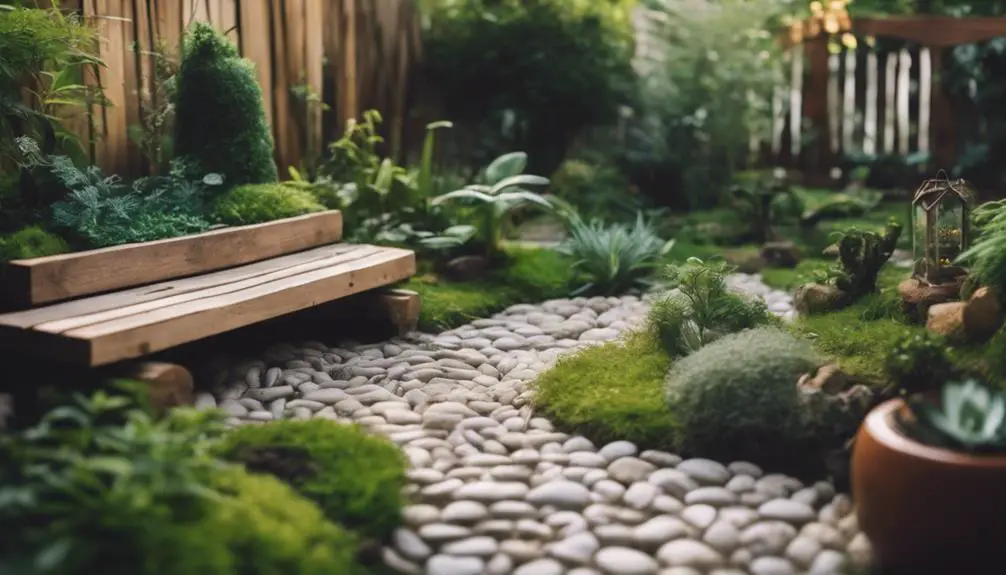
As you plan your DIY garden decor projects, you'll want to ponder the visual elements that will bring your outdoor space to life.
You'll have the opportunity to get creative with garden stone artistry, repurpose items into unique planters, and incorporate nature-inspired accents that reflect your personal style.
Garden Stone Artistry
You can transform your backyard into a visually stunning outdoor space by incorporating garden stone artistry, a unique form of DIY garden decor that combines natural beauty with creative expression.
By incorporating stone carvings and garden ornaments, you can add a touch of elegance and sophistication to your outdoor space. Stone carvings can be used to create intricate designs, patterns, and shapes that can be placed throughout your garden, adding visual interest and depth.
Garden ornaments, such as statues, figurines, and sculptures, can be strategically placed to create a sense of balance and harmony.
To create a cohesive look, consider choosing a theme or style for your garden stone artistry. For example, you could opt for a modern and sleek look with geometric shapes and clean lines, or a more whimsical and romantic look with curved lines and organic shapes.
Repurposed Planters Ideas
By repurposing unexpected items as planters, you can add a touch of personality to your garden stone artistry while reducing waste and creating unique DIY garden decor projects that showcase your creativity.
Think beyond traditional planters and explore the possibilities of upcycling old, discarded items. For instance, transform a vintage suitcase into a charming garden by filling it with a mix of herbs, succulents, or flowers. The worn leather and rusty hardware will add a nostalgic touch to your backyard.
Old boot planters are another great option. Simply drill drainage holes in the soles, add a layer of potting soil, and plant your favorite flowers or herbs.
You can also get creative with the boots' design by painting or decoupaging them to match your garden's color scheme. To take it to the next level, arrange multiple boots in a staggered formation to create a visually appealing display.
Nature-Inspired Accents
Embracing the beauty of nature, incorporate organic elements into your backyard landscaping with DIY garden decor projects that feature natural accents, such as weathered wood, river rocks, and moss-covered stones.
These nature-inspired accents will add depth and character to your outdoor space, creating a seamless shift between your garden and the surrounding environment.
To create a forest-like ambiance, incorporate forest fragments into your design. Use fallen branches to create a unique trellis or add a touch of whimsy with a moss-covered stone bench.
You can also incorporate nature nuances by adding a statement piece, like a large river rock or a reclaimed wood sculpture, to draw the eye towards a specific area of your garden.
When selecting materials, consider the natural textures and colors of the elements you're working with.
Weathered wood, for example, can add a warm, rustic touch to your design, while moss-covered stones can bring a sense of serenity and calm.
Outdoor Lighting Inspiration

Softly glowing pathways, strategically placed spotlights, and ambient lanterns transform your backyard into a warm and inviting oasis after dark.
As you design your outdoor space, consider the impact of landscape lighting on the ambiance boost it provides. You'll want to create a layered lighting effect, combining different types of lighting to achieve a cohesive look.
Start by highlighting focal points, such as a statement tree or water feature, with spotlights. Then, add ambient lighting, like string lights or lanterns, to create a warm glow.
Don't forget to incorporate pathway lighting, which not only provides safety but also guides visitors through your outdoor space.
To take your lighting design to the next level, consider using smart lighting systems that allow you to adjust brightness and color temperature with the touch of a button.
With a well-planned landscape lighting scheme, you'll be able to enjoy your backyard oasis long after the sun sets.
Natural Stone Walkway Designs
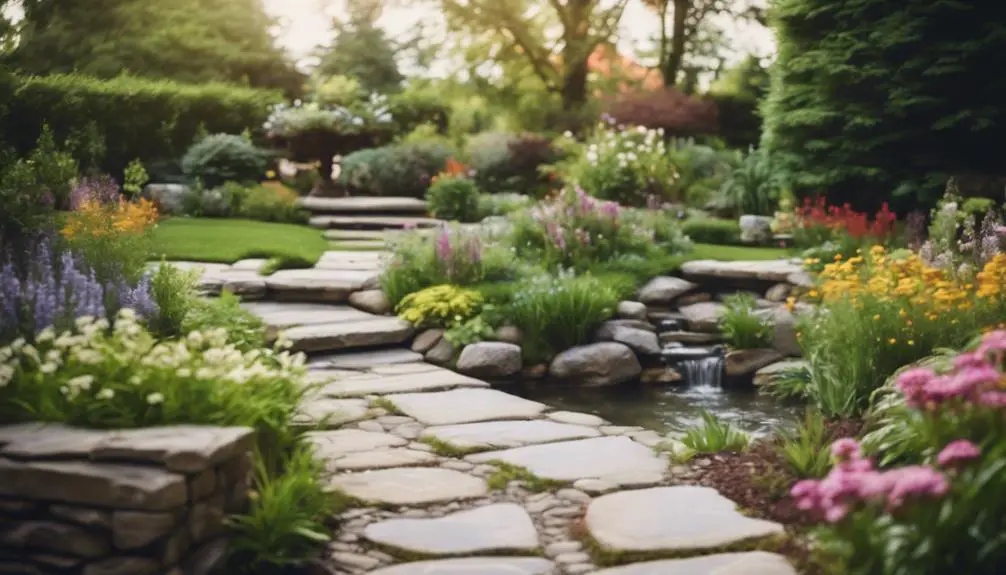
Six carefully crafted natural stone walkway designs can elevate your backyard's aesthetic, creating a seamless shift between outdoor spaces.
You'll want to ponder the unique characteristics of each stone type, such as bluestone's subtle blue-gray hue or fieldstone's rustic, irregular shape.
To add visual interest, experiment with stone patterns, such as a running bond or herringbone design.
Pebble accents can also be used to create a striking contrast between large stone slabs and smaller, rounded pebbles.
When selecting a natural stone walkway design, think about the overall style you're aiming to achieve.
Do you prefer a modern, sleek look or a more rustic, organic feel?
Ponder the color palette of your outdoor spaces and choose stones that complement or contrast with them.
You may also want to incorporate other design elements, such as plantings or outdoor furniture, to create a cohesive look.
Small Yard Space Solutions
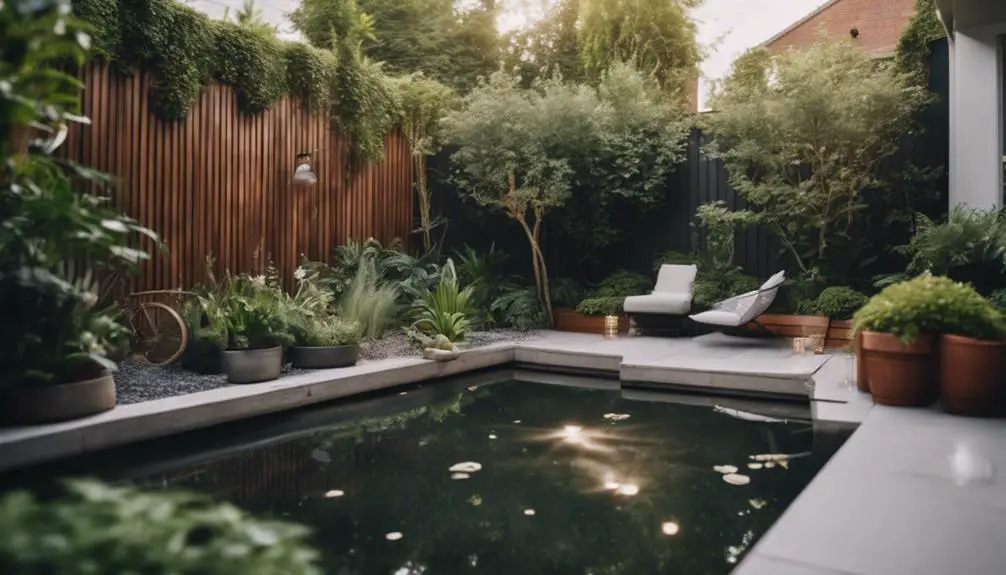
Your compact backyard can still make a big impact with thoughtful space planning and clever design strategies that maximize every square foot.
By incorporating space savers, you can create a functional and aesthetically pleasing outdoor space. Consider vertical gardening, where you can train vines or climbing plants to grow up trellises or walls, freeing up floor space for other elements.
Yard optimization is key, so assess your yard's dimensions and identify areas where you can create separate zones for dining, lounging, or entertainment.
To create the illusion of more space, use mirrors or reflective surfaces strategically placed to bounce light and create a sense of depth.
Divide your yard into smaller, intimate areas using hardscapes like pavers, stones, or gravel. This will help to break up the space and create a sense of visual interest.
By applying these design principles, you can turn your small yard into a vibrant, functional oasis that's perfect for relaxation and entertainment.
With a little creativity and planning, your compact backyard can become a true retreat that you'll love spending time in.
Water Feature Installation
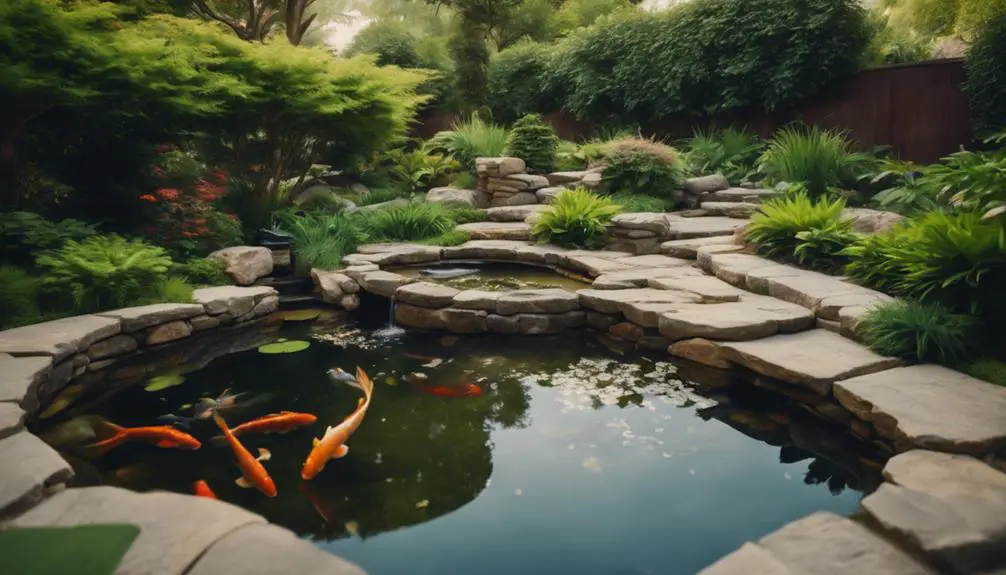
When incorporating a water feature into your backyard landscape, ponder the visual and auditory impact it will have on the overall ambiance, and choose a design that complements your outdoor space.
A well-designed water feature can transform your yard into a serene oasis, perfect for relaxation and entertainment.
To create a stunning water scape, start by selecting a fountain design that fits your style and budget. Take into account the size and shape of your yard, as well as the surrounding architecture, to guarantee a harmonious integration.
You can opt for a self-contained fountain, which is easy to install and maintain, or a more complex system with multiple components, like a pond and waterfall.
Don't forget to ponder the sound and sight of moving water, as it can greatly enhance the overall experience.
For a modern twist, incorporate LED lighting or other innovative features to create a truly unique water feature.
Backyard Fire Pit Ideas

As you extend your outdoor living season into the cooler months, a backyard fire pit becomes a warm and inviting focal point, allowing you to gather 'round and savor the company of friends and family on crisp autumn evenings or snowy winter nights.
To create a cozy ambiance, consider a fire pit with a sleek, modern design, such as a gas-powered pit with a stone or metal surround.
When selecting a fire pit, prioritize pit safety by choosing a model with a sturdy base and a protective screen to contain sparks. Guarantee the pit is at least 10 feet away from flammable structures and overhanging branches.
For added comfort, incorporate seating options, like built-in benches or Adirondack chairs, to create a inviting gathering space.
Don't forget to incorporate adequate lighting, such as string lights or lanterns, to enhance the ambiance and provide visibility after dark.
Native Plant Species Benefits
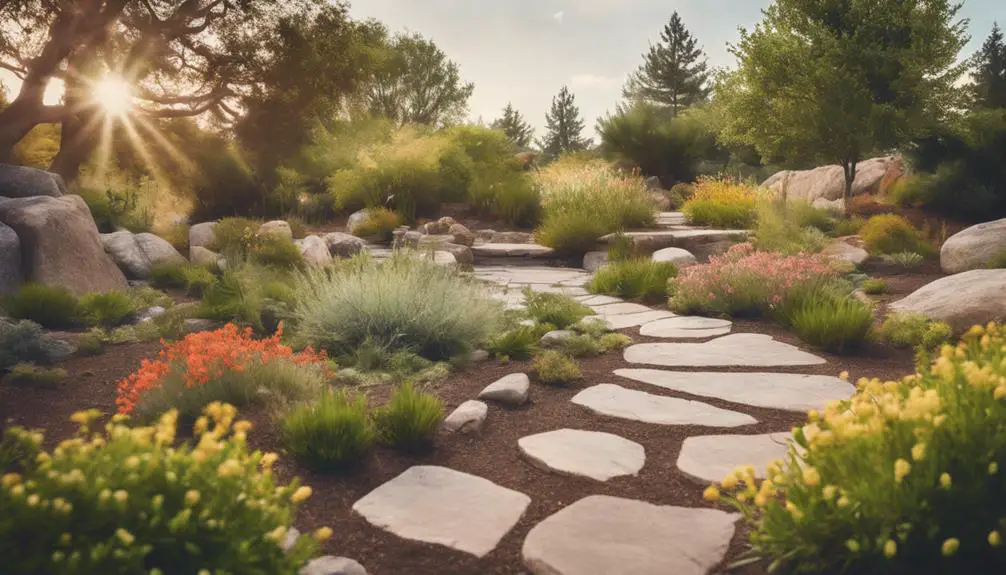
When you choose native plant species for your backyard landscaping, you're not only supporting local ecosystems, but you're also reaping the benefits of low maintenance needs and a unique aesthetic value that's inherent to your region.
By incorporating these plants into your design, you'll create a cohesive look that's tailored to your climate and soil type.
As you explore the advantages of native plant species, you'll discover how they can elevate your outdoor space while minimizing upkeep and environmental impact.
Local Ecosystem Support
By incorporating native plant species into your backyard landscaping, you're creating a haven that supports local biodiversity and strengthens the regional ecosystem, ultimately benefiting the environment and your community.
This deliberate choice reinforces biodiversity conservation by providing a habitat for native wildlife, allowing them to thrive in their natural environment. Native plants have co-evolved with local wildlife, ensuring a delicate balance that sustains the ecosystem.
As you design your backyard oasis, consider the specific needs of local species.
For instance, native bees rely on specific plant species for pollen and nectar, while butterflies require host plants for their caterpillars.
By incorporating these plants, you're creating a wildlife habitat that supports the entire food chain. This not only benefits local wildlife but also enhances the aesthetic appeal of your backyard.
Imagine a vibrant ecosystem teeming with life, where native plants and wildlife coexist in harmony.
Low Maintenance Needs
Native plant species, adapted to your region's climate and soil conditions, require less pruning, watering, and fertilizing, freeing you from tedious yard work and allowing you to enjoy your outdoor space.
This means you'll spend less time tending to your garden and more time relaxing in it.
With native plants, you can say goodbye to frequent watering sessions, as they're naturally resistant to drought and can thrive with minimal hydration. You'll also reduce your fertilizer usage, as native plants have evolved to extract the necessary nutrients from the soil.
This Easy Upkeep translates to more time for you to appreciate the Simple Beauty of your backyard oasis. Imagine strolling through your garden, surrounded by lush greenery and vibrant blooms, without the burden of constant maintenance.
Unique Aesthetic Value
Your backyard landscape takes on a unique character with native plant species, as their diverse textures, colors, and forms create a visually intriguing tapestry that invites exploration and discovery.
By incorporating native plants, you'll create a dynamic visual experience that engages the senses and fosters a deeper connection with nature.
You can strategically place native plants with striking features, such as vibrant flowers or architectural foliage, to create focal points that draw the eye and guide the viewer through the landscape.
This thoughtful placement also promotes visual harmony, as the diverse elements work together to create a cohesive and balanced composition.
Native plants' natural adaptations to local conditions also guarantee that your landscape will evolve and change with the seasons, providing a dynamic and ever-changing visual experience.
Outdoor Kitchen Design Guide
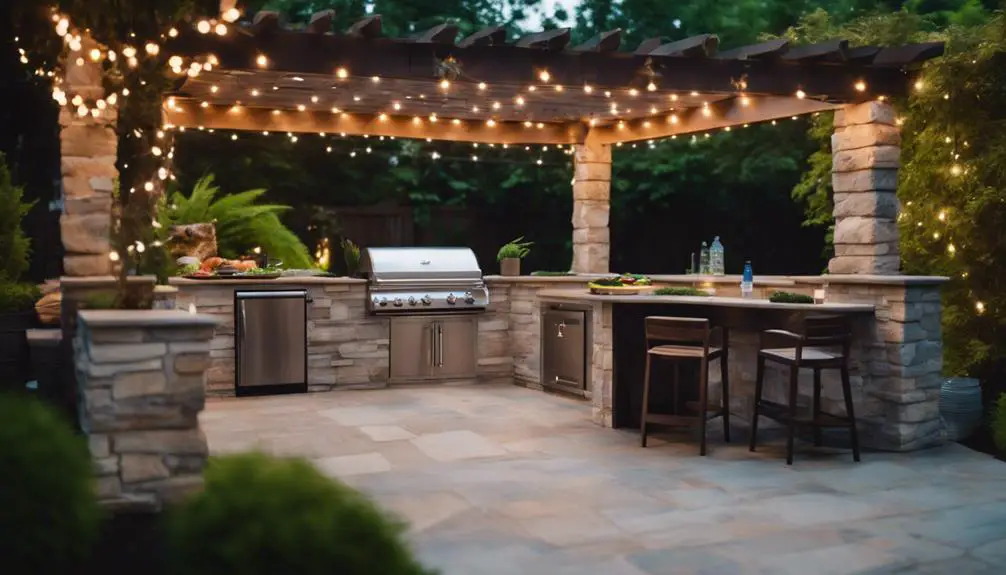
With a thoughtful outdoor kitchen design, you can seamlessly integrate cooking, dining, and socializing into a single, functional space that maximizes your backyard's potential.
To achieve this, crucial consideration must be given to the kitchen layout. Consider a galley layout, where counters and appliances are arranged in a linear fashion, allowing for efficient workflow and conversation.
Alternatively, an L-shaped layout can create a sense of separation between cooking and dining areas.
When selecting countertop options, durability and low maintenance are key. Natural stone, such as granite or bluestone, provides a sophisticated look and can withstand outdoor elements.
Concrete countertops, with their versatility in color and texture, offer a modern aesthetic.
Don't forget to incorporate functional features like built-in cutlery drawers, utensil holders, and a sink with a built-in water filter.
Vertical Gardening Techniques
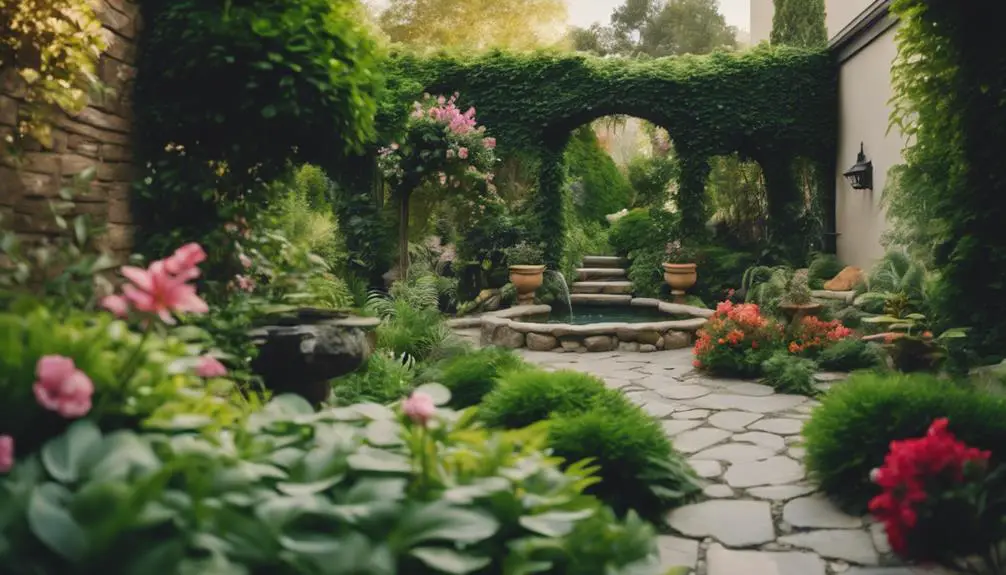
To maximize space in your backyard, consider incorporating vertical gardening techniques that utilize walls, trellises, or arbors to train vining plants upwards, thereby increasing yield while minimizing footprint.
This approach not only optimizes your yard's dimensions but also adds visual interest and texture to your outdoor space.
Living Walls, a popular vertical gardening method, involve training plants to grow up a trellis or wall, creating a lush, green facade.
Green Screens, on the other hand, are freestanding or wall-mounted planters that provide a natural screen or divider.
By using a trellis or arbor, you can train climbing plants like ivy, clematis, or wisteria to grow upwards, creating a beautiful display of foliage and flowers.
To get started, choose a location with adequate sunlight and soil quality, and select plants that thrive in vertical conditions.
With proper care and maintenance, your vertical garden will flourish, providing a unique and innovative touch to your backyard landscape.
Budget-Friendly Landscaping Tips
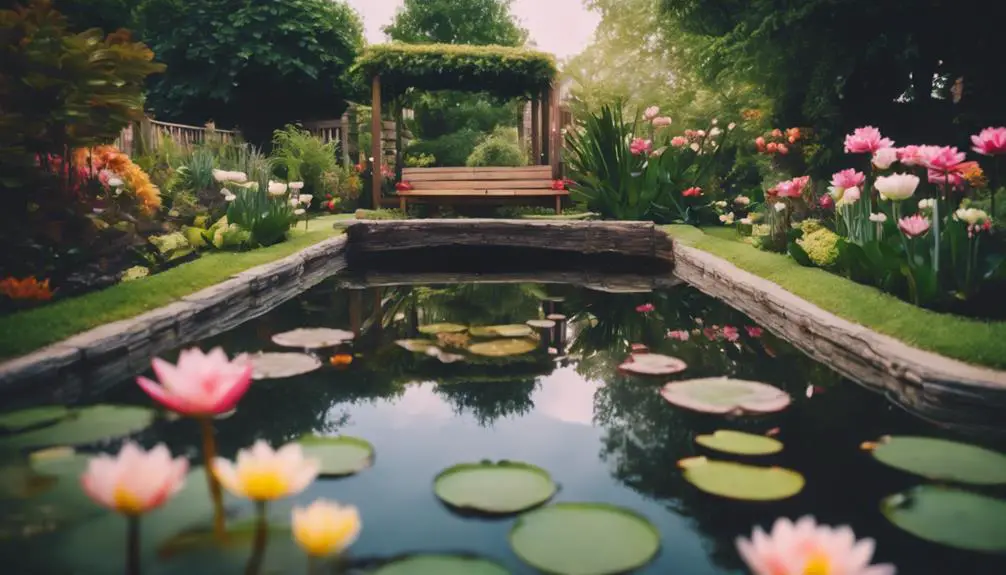
Five essential budget-friendly landscaping tips can help you achieve a stunning outdoor space without breaking the bank. You don't have to sacrifice style for savings, and with these cost-effective solutions, you can create a beautiful backyard on a budget.
First, create a budget breakdown to prioritize your spending. Identify the areas that need the most attention and allocate your funds accordingly. Next, repurpose materials you already have, such as old pots, bricks, or stones, to reduce waste and save money.
Consider DIY projects, like building a raised bed or creating a succulent garden, which require minimal materials and labor. When selecting plants, opt for low-maintenance, drought-resistant species that will thrive with minimal care.
You can also shop for plants during off-peak seasons or look for discounts at local nurseries. Finally, don't overlook the power of mulch, which can enhance your landscape's appearance while suppressing weeds and reducing water consumption.
Frequently Asked Questions
How Do I Prevent Soil Erosion on a Sloping Backyard?
To prevent soil erosion on your sloping yard, you'll need to implement slope stabilization and erosion control measures, such as terracing, retaining walls, or geotextiles, to effectively redirect water flow and secure the soil in place.
Can I Use Mulch to Suppress Weeds in My Garden?
You can effectively use mulch to suppress weeds in your garden by applying a 2-3 inch layer of organic mulch, like wood chips or bark, and combining it with a weed barrier, such as landscape fabric or plastic sheeting.
What Are the Best Plants for a Shaded Backyard Area?
You'll thrive in shaded areas with ferns, hostas, and astilbe, which create a lush, verdant atmosphere. Consider a fern garden design featuring shade-loving perennials like bleeding heart and heuchera to add texture and depth to your outdoor space.
How Often Should I Prune My Trees and Shrubs?
You'll want to prune your trees and shrubs regularly to maintain their health and appearance. For ideal tree care tips, prune annually, removing dead branches and shaping for air circulation. Shrubs require seasonal shrub maintenance, trimming every 4-6 weeks to promote dense growth.
Do I Need a Permit to Install a Backyard Pond?
You'll likely need a permit to install a backyard pond, as it affects local water tables and ecosystems. Guarantee you comply with regulations, considering pond maintenance and water quality, to avoid environmental and legal issues.
Conclusion
By incorporating a mix of textures, colors, and shapes, you've created an inviting outdoor space that's perfect for relaxation and entertainment.
With separate zones for dining, lounging, and entertainment, your backyard has become a serene oasis.
Remember to maintain your native plants, which will thrive with minimal upkeep, and enjoy the ambiance of your outdoor lighting.
Your outdoor space is now a reflection of your personal style, and you'll love spending time in this beautiful retreat.




